Answers to discussion topic questions in Unit 4
Please make sure you understand the answers before you attempt the practice
quiz or unit test. Many of these answers came from your fellow students.
Photovoltaics
- In what ways did light behave to convince scientists that it was a wave?
Isaac Newton argued with Christen Huygens about the
nature of light way back in the late 1600's. Newton believed light was a
particle (corpuscles) and Huygens argued the wave nature of light.
Neither could offer compelling evidence but Newton's view prevailed mainly
because of Newton's stature in the scientific community.
However, Thomas Young performed an experiment in 1801 that demonstrated the
wave properties of light. It was known as the "double slit" experiment
and a great applet can be seen
here. It was
known that two waves (in water) can work together to produce a larger wave
(called constructive interference) or can cancel each other out (destructive
interference). Young allowed light to pass through two closely spaced
slits. A pattern of light and dark spots appeared on a screen. The
only way this could be explained was assuming light behaved like waves ...
creating bright spots where the waves (emanating from each slit) met "in
phase" and dark spots where they canceled each other out, ... arriving "out of
phase" with respect to each other.
- From a physics standpoint, why is it more likely that we will receive
coded transmissions from extraterrestrials in the radio portion of the
electromagnetic spectrum than from any other area?
There are several reasons why radio waves are the smart
choice for interstellar communications. The one I was soliciting from
you was from an energy perspective. Radio waves have the lowest
frequency and, therefore, the lowest photon energy (E=hf). If you want
to talk, talk cheap. In addition to that, radio waves can penetrate the
gas and dust that is usually opaque in other areas of the spectrum. This
is why radio telescopes became such an important part of astronomy because it
can "see" past the gas and dust in space. One last reason why ET would
talk to us in radio deals with "noise". Many natural phenomena emit
radiation at all parts of the electromagnetic spectrum. There are
several frequencies in the radio section of the EM spectrum that are "quiet".
- Another way of converting sunlight to electricity uses "parabolic
troughs". Briefly explain how that works and list some other practical
applications of this device.
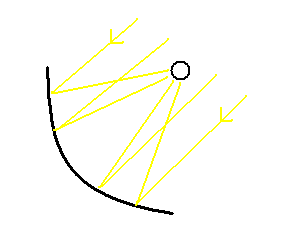
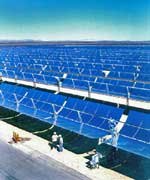
The trough is a curved mirror which concentrates
sunlight to a focal point which becomes extremely hot. A tube with a
fluid inside absorbs the heat and can be used to produce steam to spin a
turbine and generate electricity. However, the heat can also be used for
water heating, industrial drying, desalination, and other applications where
heat is required.
- This section deals with generating electricity directly from sunlight.
What are the top three "fuel sources" we currently use to generate electricity
in the US (indicating percentage for each)? Which one is considered a
"renewable" source?
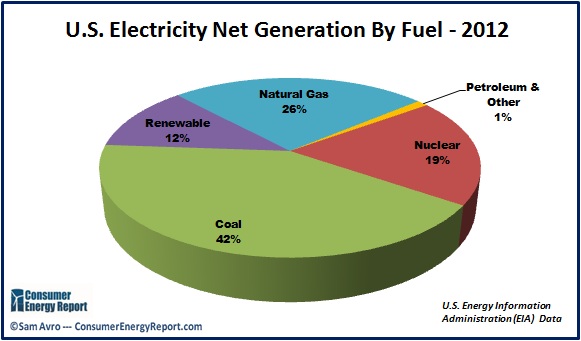
Source:
http://www.energytrendsinsider.com/2012/02/21/how-much-can-renewables-bite-out-of-the-coal-pie/
Most of the electricity in the US is generated
from coal (42%), natural gas (26%) and nuclear (19%). None of these are
considered renewable. The heat is used to produce steam to spin a
turbine which turns a generator. It should be noted that natural gas has
moved up the list like a bullet in the past decade mainly due to the abundant
supply provided from the fracking of oil shale. It will not be long until
natural gas moves to the top of the list (if it hasn't already).
- List at least three other ways electricity can be generated using a
renewable energy source.
Hydroelectric power (7%) is renewable but only practical
where there is a lot of rain and vertical terrain to dam huge volumes of
water. In the Pacific North-West, water is released from the dam which
spins the turbine making hydro the cheapest and cleanest fuel available. Unfortunately, if you do the math on the last question
you will see that alternative sources of energy are almost squeezed out of the
pie chart ... for now. By 2015, Wisconsin utilities will be required to
produce 10% of their electricity from renewable sources.
Wind power is slowly
becoming a contender but is still a very minor player in the game. Other
renewable ideas include biomass. We already mix our gasoline with 10%
ethanol and flex fuel cars can run on E85 (85% ethanol). This fuel can
just as easily be used to generate steam to spin a turbine and make
electricity. However, ethanol in the US is produced from corn (a
valuable feedstock). Perhaps a better solution is to convert the energy
in landfills (methane or bio-gas), prairie grasses, algae, pulp wastes, and other
agricultural wastes to produce bio-fuels. This is known as cellulosic
ethanol and could be big. We could use this to run our cars or generate
electricity. This would also be a huge step
in solving another problem of global warming because these ideas are virtually
carbon neutral (meaning they don't add to the atmospheric carbon dioxide
emissions that are common with fossil fuel burning). If you are
interested in leaning more about these ideas, consider taking NatSci 169 -
Energy - Nature, Technology, and Society at MATC.
If you think about all the choices listed above you may see that the sun is
the ultimate source. The sun's energy is stored (via photosynthesis) in
plants. The sun heats the earth and drives the winds. The sun
evaporates the water to drive the water cycle. Another renewable is
geothermal energy. This comes from the radioactive decay of rocks below
our feet. We don't live in Iceland so this energy source is somewhat
limited in the US but one interesting option is the geothermal heat pump to
heat your home. This is covered in the next unit.
- LED flashlights are readily available but what about LED light bulbs?
Are household white light LED bulbs on the market now! If so, what is
the highest light output available (in lumens)? Relate the power
consumption to a standard incandescent bulb of the same luminosity. Also
compare the initial cost (and life expectancy).
LED bulbs are here to stay. In 2018, the most common was 60 Watt
equivalent with a light output of 815 lumens but higher outputs were
available. I purchased a 60 Watt equivalent bulb that uses only 11 Watts
and is expected to last for 25,000
hours (2.85 years) .... for only about $1. Considering that the cost a decade ago was about $100 ... well, that is quite
a price drop. So, is it worth the cost to replace your bulbs with LEDs? Let's do some math.
We Energies sells power for about $.13 per kWh (in 2015). This LED bulb
will use 275 kwh of electricity is its lifetime (.011kw x 25,000 hours).
This costs $36 (275 x .13) of electricity to actually run this bulb.
Total cost, about $1 + $36 = $37.
Now lets look at the 60 watt incandescent bulb. It takes about 3 bulbs
to last as long as this single LED bulb. Big deal ... cost $1.
To run a 60 watt bulb for 25,000 hours you would use 1500 kwh of electricity
(.060kw x 25,000 hours). The cost of electricity is $.13 x 1500 ... or
$195 Wow!!! If you even care to add in the extra $1 cost of the
bulbs you have paid $196.
The savings is $159 over the life of the LED bulb. Maybe even better,
these bulbs contain no mercury (which is found in compact fluorescent bulbs).
- In what way is an LED used in the older conventional mouse (with a roller
ball)? How is movement by the mouse translated to digital signals?
There is a ball that is
located inside the mouse and this ball moves when it touches the desktop. One of two rollers is
positioned so that can detect motion in a certain direction (x direction for one
roller and y direction for the other roller), and one or both of the rollers
will rotate along with the ball. The rollers are
connected to a shaft. There is a disk with holes in it and the shaft makes it
spin.
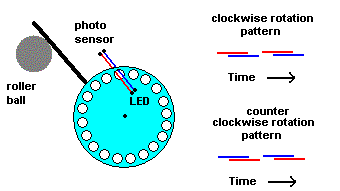
The disk (with holes in it) contains
an infrared LED, and an infrared sensor. The infrared sensor sees pulses of
light because the holes in the disk break the beam of light from the LED. To distinguish between clockwise and
counterclockwise motion, two LEDs are used. The pattern is different
depending on which way the wheel spins. See the animations below:
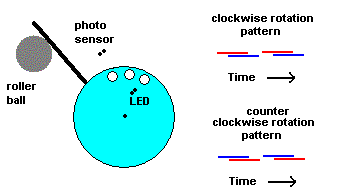
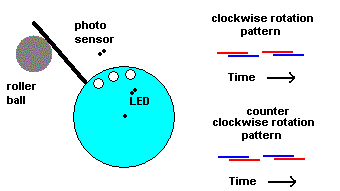
The on-board processor chip reads
the infrared sensors pulses and turns them into
binary data that the computer can understand. The chip sends the binary data to
the computer through the mouse's cord.
Often a mouse will become unresponsive. This is because dirt builds up
on the rollers where the mouse ball makes contact with it. If you clean
off the dirt (rubbing alcohol and a Q tip) and wash the mouse ball in soapy
water, it will work as good as new.
- In what way is an LED used in an optical mouse. How is movement by the
mouse translated to digital signals?
The LED is used to illuminate the surface. A laser
mouse does the same thing but is more precise (and often works in the infrared
so you don't ever see any light). An array of photo sensors capture an
image of the surface. By taking many images of the surface it can
compare one image with another and determine if the mouse moved and if so, by
how much. The neat thing is that it never needs cleaning and can work on
just about any surface.
Mass Storage of Electricity: One obstacle dealing with
renewable sources of electricity (solar, wind, etc) is storage. All
power plants today generate just enough electricity to meet demand. If
solar (or wind) are to take a leading role, they have to find ways of storing
and delivering electric power even when the sun isnít shining (or the wind
isnít blowing). What are some ideas to solve this problem? Please
list one (per student) along with a brief overview how it works.
On February 27, 2008 western Texas experienced a high
demand for electricity and no wind to fill the demand. Grid operators
were forced to cut electricity to offices and factories to avoid a state wide
blackout. This is a taste of the future (as we try to move away from
non-renewable sources) unless we find ways of mass storage. One solution
is to simply purchase excess electricity from a neighboring country or state.
(Not such a good idea if they can't come through in a pinch.) Another
solution is to use excess electricity to pump water uphill and tap it
(hydro-power) during
periods of peak demand. A third choice is to compress air (in
underground caverns) and use it to spin a turbine when needed. One
student wrote about a
project in New York that will use a huge flywheel for frequency stability
but the same idea can be used to store energy. Another
student found a system that would use excess power to cool air to a liquid.
During peak loads, the liquefied air would vaporize, spinning a turbine in the
process. Another student found a power plant in Spain which would use
solar energy to melt
salt during the day and use the stored heat (at night) to make steam. One last
idea is to use batteries for mass storage. This is currently very
expensive but hope is on the horizon if new ideas like the
vanadium redox flow battery can be made to work.
Still another idea is to move away from a centralized grid entirely and let
individual homes store their own power. The
Tesla Powerwall is one such example.
Work in this area is still in the embryonic stage.
The thought is to develop systems on the "micro-grid" scale and test the
feasibility. Wisconsin will be leading the way with a cooperative
effort that will involve MATC and local industries. Read more
here.
Other Ideas for Solar: Sunlight can do more for us than generate electricity.
What are some other ways we can save energy by using sunlight?
In the 70's I obtained 100% of my hot water from April -
October from a solar water heater (which I built myself). At the time I
lived in an area without natural gas so I was forced to use (expensive)
electricity to supply my hot water during the winter months (when the solar
panels were much less efficient). The panels simply heated a fluid (in
my case - air) to collect heat and transfer it to water. On a recent
trip to Hawaii, I noticed that rooftop water heaters were common. In
addition to heating water, the sun can be used for space heating. Even
in Wisconsin, a well designed passive solar house can save 50% on
heating bills over a traditional house. The problem is, a passive solar
house requires an active owner. Steps must be taken to allow solar
radiation to enter the home during the day, and not let it escape out windows
during the night. Can you tell I taught a class in solar energy in the
70's?
Capacitors
The first capacitor was called a Leyden jar. What did it look like,
how did it work, how did it get its name, and what was the controversy
regarding its discovery? Match the parts of the Leyden jar with
corresponding parts of modern capacitors. (Where are the plates, what serves
as the dielectric?)
As a review, a capacitor traditionally has
two metal plates facing each other. Put the terminals of a battery to each
plate and one plate is charged positive and the other acquires an negative
charge. You can remove the battery and it retains this electric charge.
If you make an electrical connection between the two plates, the capacitor will
discharge all at once. In the Leyden jar, metal foil (which represents one
plate) is lined on the outside of the jar and either water or another metal foil
is on the inside of the jar (the other plate). The glass acts as an insulator (to
prevent discharge) and acts as the dielectric.
The Leyden jar was one
of the first capacitors and is really quite easy to make. You could
actually just place a small amount of water in a jar and run a wire from the
inside (touching the water) which runs to the outside of the jar. If you
place a static charge on the wire, the water in the jar will "hold" this charge.
Anyone touching the wire and a grounded piece of metal would get a zap. An
improvement has a thin metal lining both on the inside and outside of the jar. You
get a zap if you touch the outside metal and wire leading from the inside metal.
The first capacitor was called the Leyden Jar because it was created at the
university of Leyden (by Pieter Van Musschenbroek).
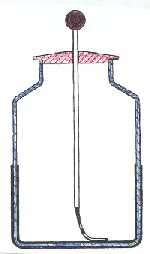
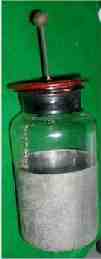
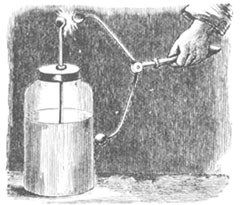

One might ask - where is the energy
actually stored in this jar? The answer is in the electric field
between the metal plates. In this case, in the glass.
The controversy surrounding the Leyden jar is this: Ewald Georg von Kleist had developed this idea
in October 1745 but failed to publish. Van Musschebrok announced his discovery in January 1746.
There was a letter published and dated February 4, 1745 in a article called Philosopichal Transactions
which suggested that the jar existed a year before that
date. The general opinion is the editor of the Philosophical Transactions may
have misdated the letter or failed to properly translate it.
Pieter Van Musschenbroek, himself, was
amazed by the power of the Leyden jar as described below in a
letter
"I wish to inform you of a new, but terrible experiment,
which I advise you on no account personally to attempt. I am engaged in a
research to determine the strength of electricity. With this object I had
suspended by two blue silk threads, a gun barrel, which received electricity
by communication from a glass globe which was turned rapidly on its axis by
one operator, while another pressed his hands against it. From the opposite
end of the gun barrel hung a brass wire, the end of which entered a glass jar,
which was partly full of water. This jar I held in my right hand, while with
my left I attempted to draw sparks from the gun barrel. Suddenly I received in
my right hand a shock of such violence that my whole body was shaken as by a
lightning stroke. The vessel, although of glass, was not broken, nor was the
hand displaced by commotion: but the arm and body were affected in a manner
more terrible than I can express. In a word, I believed that I was done for."
Uses for Capacitors (from students)
I stumbled upon a Nissan article talking about how they plan to replace the
lead-acid battery for a "superpower" capacitor in their hybrid vehicles and I
thought that this would be a good example of how a capacitor is used to store
energy. I don't understand how it would distribute that power unless it just
uses resistors like you said in the reading. Here is the link:
http://findarticles.com/p/articles/mi_m0CYH/is_2_7/ai_97757261
Here is material taken directly from the article:
Capacitors not only deliver unlimited charge/discharge cycles (unlike
batteries), but offer dramatic weight savings (one-third the weight of
batteries) and much greater instantaneous power. The latest EDLC
technology delivers tens or hundreds of seconds of power for acceleration, and
only requires a few seconds of braking to recharge, unlike conventional
batteries. In contrast, batteries take hours to discharge power, but frequent
regeneration and discharge means greatly reduced battery life.
Capacitors also don't face hazardous material recycling/disposal issues as
with lead-acid or nickel, both of which are toxic materials.
______________
A capacitor can be used in a subwoofer system in a car. I have one in my
car. It stores energy in it so it does not take away any power that is in the
battery. For ex. your headlights, dash lights, stereo deck and many other
things are already taking power from the battery. When you add something like
a 2000 watt amp it really drains the battery. So if you have a capacitor it
will store the energy for the amp and wont put a drain on the battery at all.
______________
Capacitors can be used as sensors by changing the distance between the plates.
If one plate is held fixed and the other plate free to move under its own
inertia, they can be used to detect changes in acceleration such as sensors
triggering airbag deployment.
I found
this
web site very useful and informative.
______________
I found an example of a "natural" capacitor. Clouds and the ground can act
together to create a very large natural capacitor. The process of evaporation
and condensation of the atmospheric water within clouds causes the water
to combine with the dust, radiation, and each other. These collisions cause
the electrons to be knocked off the particles creating a separation in
the clouds due to a charge. Negative electrical charges are formed at the base
of the clouds. These charges induce positive charges into the ground. The air
between the clouds and the ground become the dielectric of this capacitor. The
electrostatic field between the two create ions and free electrons in the air.
The difference in voltage between the clouds and the ground can become so big that the
air dielectric begins to wear down. The ions and free electrons provide a
basic path that short circuits this capacitor, which causes a flash of
lighting.
_______________
I just heard of a safety saw that can tell the difference between a finger and
a piece of wood. The brand name is
SawStop and they show a demo with a hotdog (in place of a finger) to
demonstrate how effective the device is. Apparently the cutting blade is
given an electric charge. If a finger gets close to the blade or touches
it, it disrupts the electric field of the blade. A sensor (probably a
capacitor) picks up this change and triggers a device to stop (and retract)
the blade. Wood has different electrical properties (capacitance and
conductivity) so it won't effect the blade motion.
_____________
Capacitors or in this cases cylindrical asymmetrical capacitors are used to
give short burst thrusts in spacecraft. The idea is the discharge of the
capacitor ionizes air and the electric field accelerates these charged
particles which act as a propellant to provide thrust.
Source
_____________
Some fingerprint sensors use capacitance sensors to generates an image of your
fingerprint. Your finger acts as one plate and the surface you touch
acts as the other plate. The ridges and valleys in your skin can be
thought of as tiny air gaps which acts as a dielectric. This is how
fingerprint scanners work on most cell phones (such as touch ID on the
iPhone).
Piezoelectric Applications (I'll just list one student post from each category ...
there are too many to list individually)
Force to Volts -
Have you seen those kid shoes that light up an LED when they walk around?
The power supply is a small battery but a team of scientists at MIT are
working on ways of harvesting small amounts of power from your shoes using
piezoelectric materials. A person walking briskly can generate 65 watts
of power from the heel strike. Imagine charging your cell phone while
you walk? The article I read talks about using the energy to power RFID
tags (you know, those ID tags you use to prevent shoplifting or speed passes).
The problem that must be overcome is to create a design that will not be
noticeable to the wearer. If you try to harvest too much power, the
person wearing the shoes feels like they are walking on sand which is
difficult.
Here are a couple of quick answers where piezoelectric crystals may be used to
change force to volts:
- Blood pressure monitors
- Electric guitar pick-ups convert the vibration of the string to an
electric signal
- Power your pacemaker by the force of the diaphragm or heart (in
development)
Volts to Force -
Sonar was developed to emit high frequency sound waves in order to detect
submarines. The waves rebound off the submarine to give away its bearing
and distance (by measuring the time for the wave to reflect back to the source).
In this instance, the pulsations of a piezoelectric crystal produced the sonic
waves by applying systematic patterns of voltage to the crystal.
Volts to Force and back to Volts -
Suppose you apply voltage to a piezoelectric crystal and it deforms ...
exerting a force on a different piezoelectric crystal (or even the same type of
crystal with a different orientation in polarity). The voltage emanating
from this second crystal will have a different voltage from the initially
applied voltage. Guess what? You just created a transformer!
If you are reading this on an LCD computer screen, there is a good chance the
high voltage required to power the fluorescent back-lighting is provided
by a piezoelectric step-up transformer.
Piezoelectric oscillators -
The class material mentions that piezoelectric oscillators act as timers in
quartz watches and to set the clock speed of computers but in reality, they are
used as timers in most electronic devices. This can include your cell
phone, radios and TVs (to count frequency) or digital audio equipment -
sound cards, DVD players, and CD players (to measure sampling rates, for
example).
Pyroelectric Applications
You already know that pyroelectric crystals are used in motion sensors
but they have another common application in the doctor's office. If your
physician places a probe in your ear to take your temperature, he/she may be
using a pyroelectric crystal. By pressing a button, a shutter (similar to
the one in a camera) opens and the amount of infrared radiation striking
the crystal is converted to an electrical signal which a microprocessor converts
to a digital temperature readout. This sure beats the old rectal
thermometer. Below are a few other pyroelectric applications which are not so common.
Portable X-ray machine - If a pyroelectric crystal is heated in a vacuum,
electrons are ejected from their surface (or a surrounding low pressure gas) and
accelerated to high speeds by the surrounding electric field. If they hit
a metallic (copper) target, they emit soft x-rays (not as energetic as medical
x-rays). Cool-X
sells a pocket sized x-ray generator for instrument celebration, x-ray film
imaging, and research.
Portable Neutron Emitter - When heated, the strong electric field produced by
these crystals is enough to ionize deuterium (hydrogen gas with an extra
neutron). These ions are accelerated by the electric field and hit a
target (a metal hydride containing deuterium) where they initiate a
fusion
reaction which release fast moving neutrons. So what can you do with a
portable neutron emitter? You can use this device for scanning luggage at
airports or to detect explosives.
Pyroelectric Crystals could be used for
killing bacteria. Using just the heat from the surroundings, the
crystals generate an electric field that has shown to kill harmful
microorganisms. Another approach is to stimulate the growth of helpful
bacteria which are capable of killing off harmful bacteria.
Want to
straighten your hair? Tourmaline flat irons use heat flow to create an
electric charge that (apparently) helps straighten your hair by sealing the
cuticles.
There is a pyroelectric
fire alarm that can detect flames directly.






